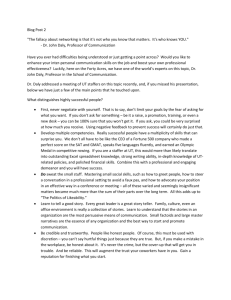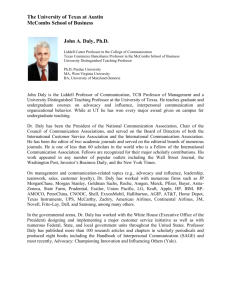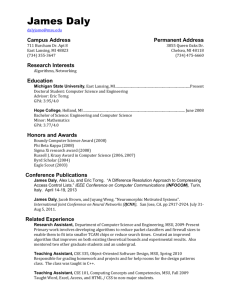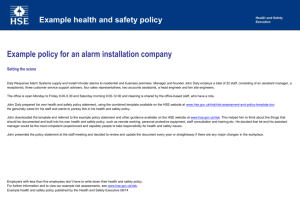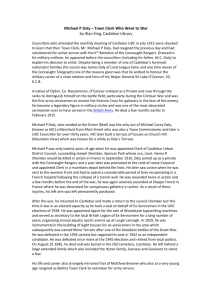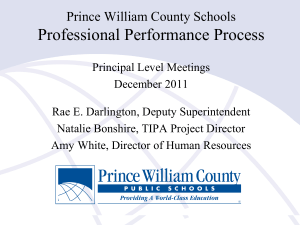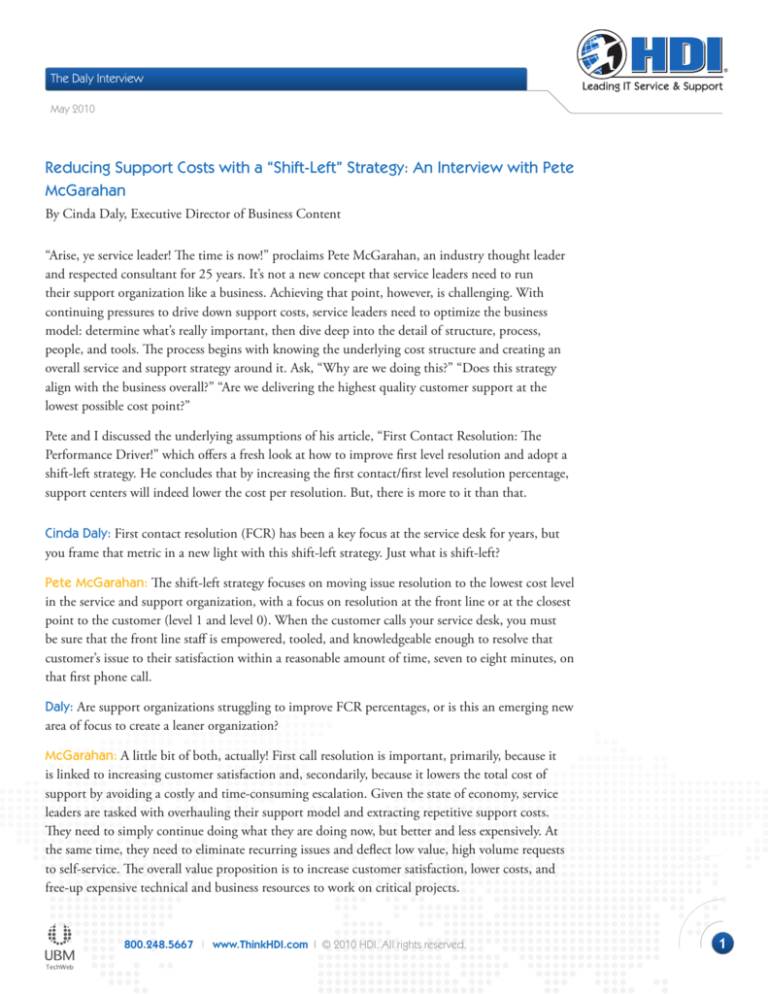
The Daly Interview
May 2010
Reducing Support Costs with a “Shift-Left” Strategy: An Interview with Pete
McGarahan
By Cinda Daly, Executive Director of Business Content
“Arise, ye service leader! The time is now!” proclaims Pete McGarahan, an industry thought leader
and respected consultant for 25 years. It’s not a new concept that service leaders need to run
their support organization like a business. Achieving that point, however, is challenging. With
continuing pressures to drive down support costs, service leaders need to optimize the business
model: determine what’s really important, then dive deep into the detail of structure, process,
people, and tools. The process begins with knowing the underlying cost structure and creating an
overall service and support strategy around it. Ask, “Why are we doing this?” “Does this strategy
align with the business overall?” “Are we delivering the highest quality customer support at the
lowest possible cost point?”
Pete and I discussed the underlying assumptions of his article, “First Contact Resolution: The
Performance Driver!” which offers a fresh look at how to improve first level resolution and adopt a
shift-left strategy. He concludes that by increasing the first contact/first level resolution percentage,
support centers will indeed lower the cost per resolution. But, there is more to it than that.
Cinda Daly: First contact resolution (FCR) has been a key focus at the service desk for years, but
you frame that metric in a new light with this shift-left strategy. Just what is shift-left?
Pete McGarahan: The shift-left strategy focuses on moving issue resolution to the lowest cost level
in the service and support organization, with a focus on resolution at the front line or at the closest
point to the customer (level 1 and level 0). When the customer calls your service desk, you must
be sure that the front line staff is empowered, tooled, and knowledgeable enough to resolve that
customer’s issue to their satisfaction within a reasonable amount of time, seven to eight minutes, on
that first phone call.
Daly: Are support organizations struggling to improve FCR percentages, or is this an emerging new
area of focus to create a leaner organization?
McGarahan: A little bit of both, actually! First call resolution is important, primarily, because it
is linked to increasing customer satisfaction and, secondarily, because it lowers the total cost of
support by avoiding a costly and time-consuming escalation. Given the state of economy, service
leaders are tasked with overhauling their support model and extracting repetitive support costs.
They need to simply continue doing what they are doing now, but better and less expensively. At
the same time, they need to eliminate recurring issues and deflect low value, high volume requests
to self-service. The overall value proposition is to increase customer satisfaction, lower costs, and
free-up expensive technical and business resources to work on critical projects.
800.248.5667 I www.ThinkHDI.com I © 2010 HDI. All rights reserved.
1
The Daly Interview
May 2010
Daly: Your key premise suggests that how an organization handles and improves first level resolution
reflects a service philosophy more than it drives efficiency metric. Please elaborate.
McGarahan: First level resolution should drive how you create a support strategy, build the
structure, and then integrate the people, process, and tools around it. Usually, organizations
want the front line to resolve as much as possible at the front line, but with a discipline to speed
resolution through escalation in order to reduce the business and productivity impact on the
customer. In all cases, we need to know what incident types we can resolve on first call, at first level,
and which ones legitimately require escalation.
At all times, we need to review the incidents we escalate and see what we need to do to enable a
FCR/FLR as well as move a FCR/FLR to self-service or target them for elimination through change
management. This strategy leads to higher customer satisfaction, lower cost, improved support
center image, and improved customer productivity.
Optimizing your service organization around FLR dictates what people and skill sets you hire and
train for. It dictates the tools you configure with best practice process so the front line can resolve
issues at the first level with minimum talk time. If you do it right, it has a positive ripple effect
across all performance metrics, the most important ones being customer satisfaction and cost.
Daly: What would be a good approach for an organization who is looking to improve FLR and
lower the cost per resolution?
McGarahan: Our mantra should be to assign the right work to the right people for the right
reasons. The guiding principle behind the shift-left strategy is to shift the resolution of the incident
or fulfillment of the request to the most cost-effective level of support. Routinely, incidents are
escalated to the more expensive teams (level 2 and level 3). We have to investigate which ones we
should target to be resolved by the front line as well as FCR types (level 1) and what can be handled
by self-service (level 0).
Daly: What is the incentive for L2 and L3 teams to cooperate and give up resolution control to the
service desk?
McGarahan: The shift-left strategy is vital in helping to free-up more expensive project resources so
they can continue to focus on implementing projects on-time, in a quality manner, and minimize
business service disruptions associated with rollouts, non-tested applications, and infrastructure
failures.
The specialty teams face many distractions that continually take them away from their focused
project work. A major cause of project delay is having project resources being pulled off of their
“task-at-hand” to dive-into the escalated incident resolution process. These regular project delays
often impact the credibility of IT with their business colleagues.
800.248.5667 I www.ThinkHDI.com I © 2010 HDI. All rights reserved.
2
The Daly Interview
May 2010
Daly: How does shift-left work, starting with level one where shifting left means self-service?
McGarahan: Begin with knowing who calls, why they are calling, and what the front line needs to
do to resolve that issue at the most cost-effective level of support. Specifically, identify all call types
that get reported into the system, know where they are being resolved (Level 1, 2 or 3), and what
needs to be done to shift the resolution of that incident left – to the most cost-effective support
level. Shifting left from the front line (L1) means that front line analysts document repetitive,
incidents and shift those left to a self-service portal where customers can help themselves anytime,
anywhere.
Daly: The service desk is tasked with the responsibility to drive their FCR metric to a higher
percentage point. How can they facilitate that?
McGarahan: First, by working more closely with their other support teams and gaining a deeper
knowledge and understanding of what it takes to resolve escalated incidents at the first contact.
Ideally, with the help of documentation, knowledge articles, remote control, training, and the like,
we can target escalated issues for a quicker identification and resolution at the front line. It would
help the service desk if they could identify the top five to seven call type categories that are both a
high and low mixture of call volume and handle time.
Daly: Who holds the responsibility to decide what to shift-left?
McGarahan: I believe that each support level team has the ultimate responsibility to investigate
the repetitive issues escalated to them and make the decision if it is a reasonable target for FCR. It
should become a routine process to look at the resolution dynamics in a cooperative, cost-reducing
way.
Daly: It’s a logical distinction with the shift-left strategy that level one focuses on incident
resolution, allowing levels two and three to focus on problem elimination, new services, and
priority projects.
McGarahan: Not exclusively, but yes. As part of their weekly and monthly problem management
responsibilities, the L2 and L3 team leaders should analyze call types and specific issues that are
being escalated to them and seek to identify their root causes. They should come up with a longterm resolution, fix, or change that would eliminate those incident-related problems from the
environment, reducing the number of calls overall.
Also, each team needs to be able to report what call types are new to the mix versus those that are
older and have been a repetitive part of the mix for the past year or longer.
800.248.5667 I www.ThinkHDI.com I © 2010 HDI. All rights reserved.
3
The Daly Interview
May 2010
Daly: How can organizations start putting shift-left into play?
McGarahan: It takes a coordinated, fully engaged effort among the service leaders at all support
levels within the organization. They all need to believe that they work for the service desk customer
and that the end result should be that the right work is done by the right people for the right
reasons. Each support team should define its own scope of services, with clearly identified roles
and responsibilities. Then, each team needs to understand who does what and why and work to
cooperate and collaborate to make them all successful.
As you look at areas to shift-left, determine what the work looks like, what it involves, what the
demand will be, what the team needs to do to take it on and be successful. . Everyone has to believe
that accepting the new work is for the right reasons. So, be sure that the accepting team has the
resources they need to be successful.
Daly: How do you show that you have lowered cost by shifting left?
McGarahan: Start by knowing your costs per analyst, cost per call, and cost per resolution.
It’s pretty simple to calculate the cost per FCR. What’s more difficult is calculating the cost per
resolution once it has been escalated and that involves multiple handoffs and resources.
To do this properly, we need to measure actual work effort involved with the resolution during the
resolution process and include all resources who worked on the issue to its eventual resolution in
the calculation. I have used a blended hourly wage for various support teams that have an escalation
cost associated with it. Then, using one of a variety of industry accepted guidelines for calculating
cost per call, per analyst or resolution, determine what the average cost would be to resolve specific
call types at the various support levels.
Next, evaluate your call types and target those you want to shift-left. Then, as you implement the
recommended action for shifting them left, monitor the impact. It’s a straightforward calculation:
last month we solved this many incidents at L2 or L3, and this month we solved Y. Then take the
reduced difference, multiply it times the average cost per call, and you have your net support cost
savings for shifting the resolution of that particular call type to a more cost effective support team.
Daly: What is a reasonable starting objective – a target goal, if you will – for an organization to start
a shift-left strategy?
McGarahan: First recognize that it’s not always about giving money or headcount back to the
company. It’s more about optimizing the support organization around the customer, making sure
you have the right people resolving incidents at the right cost level.
Organizations should adopt a call elimination strategy that aims at reducing redundant and
repetitive calls by 10% yearly. That effort is aimed at minimizing the business impact of repetitive
800.248.5667 I www.ThinkHDI.com I © 2010 HDI. All rights reserved.
4
The Daly Interview
May 2010
incidents and increasing the front line bandwidth so they can take on new, valued-added work
without increasing headcount. For example, if a call costs $25, and you get 2,500 redundant
calls a year, you can work the math. It’s a cost savings of more than $6200, and that’s just for one
redundant call type. You’ll realize the benefit of shift-left rather quickly.
Daly: We’ve come full circle. The value proposition is strong for optimizing the support center with
improved first contact resolution.
McGarahan: The shift-left strategy, with the emphasis on first call resolution, is the core strategy
for single point of contact service desks. If I focus on FCR and the philosophy around shift-left,
it forces me every day to ensure that my team is putting industry best practices to work to drive a
higher first call resolution. If we do shift-left correctly, we’re assigning the right work to the right
people for the right reasons. Everybody wins!
800.248.5667 I www.ThinkHDI.com I © 2010 HDI. All rights reserved.
5
The Daly Interview
May 2010
About Pete
Peter J. McGarahan is the founder and president of McGarahan &
Associates. Pete recently served as the Chairman of the IT Infrastructure
Management Association, a sister organization to HDI. Pete offers twentyfive years of IT and business experience helping IT organizations optimize
their service delivery model to support business objectives. His value to
the service and support industry and business is his thought-leadership.
As a practitioner, product manager, and support industry analyst and
expert, he has influenced the maturity of the service and support industry.
His passions for customer service led the Taco Bell® support organization to achieve the HDI
Team Excellence Award. IT Support News also named him one of the “Top 25 Professionals in
the Service and Support Industry” in 1999. Support professionals voted McGarahan “The Legend
of the Year” in 2002 and again in 2004 at the Help Desk Professionals conference for his endless
energy, mentoring, and coaching and his valuable contribution to the support industry and
community.
About HDI
HDI is the world’s largest IT service and technical support membership association and the
industry’s premier certification and training body. Guided by an international panel of industry
experts and practitioners, HDI is the leading resource for help desk/support center emerging
trends and best practices. HDI provides members with a vast repository of resources, networking
opportunities, and the largest industry event, the HDI Annual Conference & Expo. Headquartered
in Colorado Springs, CO, HDI offers training in multiple languages and countries. For more
information, call +1 719.268.0174 or visit www.ThinkHDI.com.
800.248.5667 I www.ThinkHDI.com I © 2010 HDI. All rights reserved.
6

